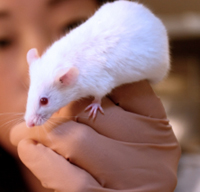Mouse
 Mice, rats and other small rodents make up the majority of animals the UK. Of these, most are mice representing 69% of the total animals used in 2006. They are small, inexpensive and easy to handle, making them ideal candidates for laboratory experiments. Their short life span and fast reproductive rate, makes it possible to investigate biological processes in many subjects, at all stages of the life cycle.
Mice, rats and other small rodents make up the majority of animals the UK. Of these, most are mice representing 69% of the total animals used in 2006. They are small, inexpensive and easy to handle, making them ideal candidates for laboratory experiments. Their short life span and fast reproductive rate, makes it possible to investigate biological processes in many subjects, at all stages of the life cycle.
The mouse makes an excellent model for human disease because the organization of their DNA and their gene expression is similar to humans, with ninety-eight percent of human genes having a comparable gene in the mouse. They have similar reproductive and nervous systems to humans, and suffer from many of the same diseases such as cancer, diabetes and even anxiety. Manipulating their genes can lead them to develop other diseases that do not naturally affect them, and as a result research on mice has helped the understanding of both human physiology and the causes of disease.
Mice are used in a vast range of experiments, many of which are classified as fundamental research, investigating the physiology of mammals. Inbred strains of mice were used as disease models, long before the mouse genome project and transgenics. There are a large number of laboratory strains available, and their long breeding history means that mice of a single laboratory strain are isogenic. This is useful in experiments, as it reduces natural variation between subjects. Some inbred strains are used for their predisposition to certain mutations or genetic diseases, while others are used for their general health and resistance to mutations.
It has been possible to clone mice since 1998.
Examples of inbred mouse strains
– NOD mice develop type 1 diabetes.
– Mice have been developed with unusual regenerative capacities.
– Waltzing mice have a mutation affecting their inner ear which causes them to walk in circles.
Last edited: 4 November 2014 17:00
